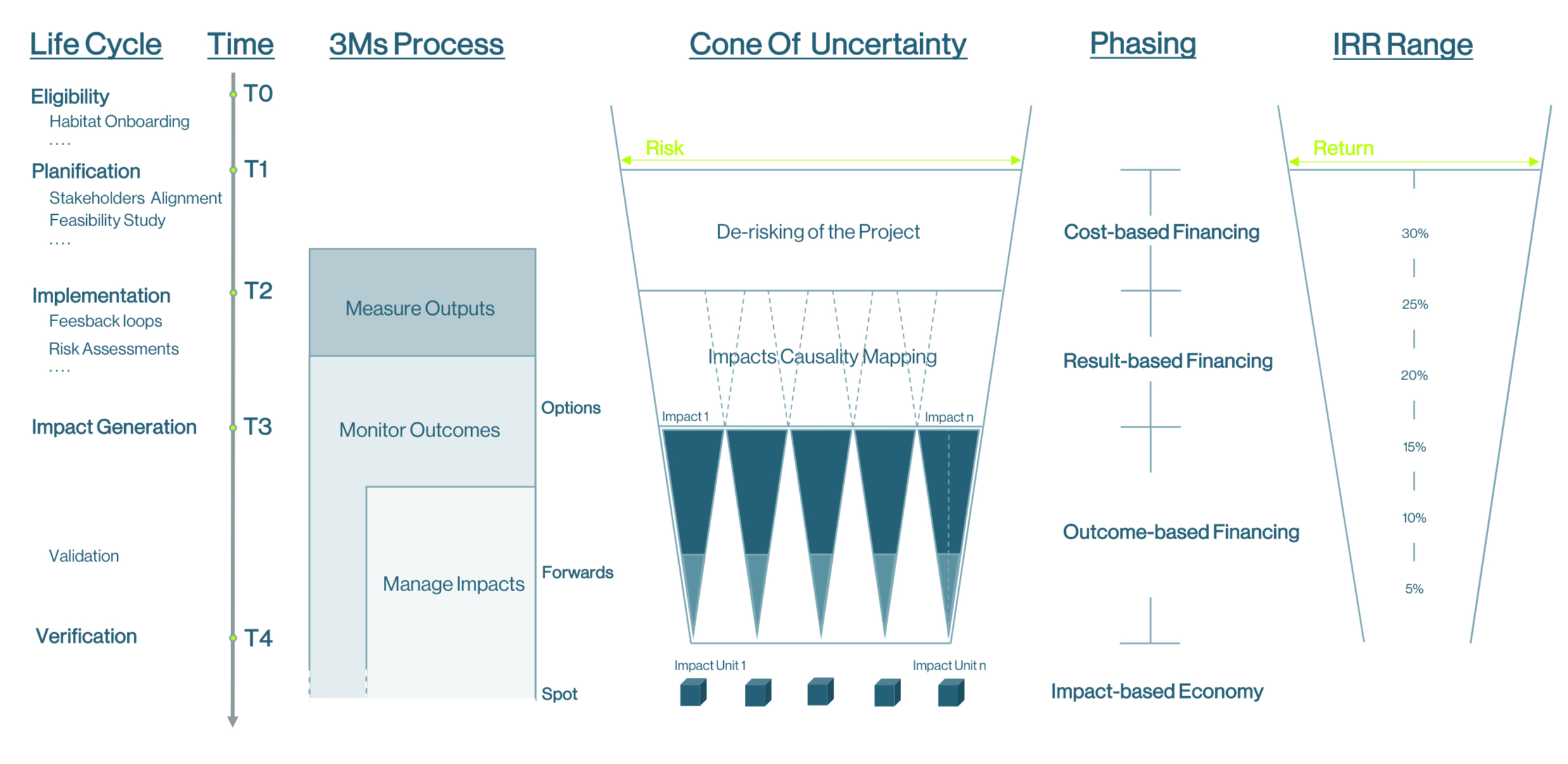Impact as a New Asset Class – Part III

Amid today’s pressing challenges, a new investment approach is emerging that embraces systemic change and prioritizes both ecological and social resilience. This approach delves into innovative financial frameworks and phased de-risking strategies that position natural and social capital as essential assets, aligning financial returns with measurable, real-world outcomes. Through this adaptive, outcome-driven model, investors are empowered to lead transformative progress, fostering a regenerative economy that supports planetary health and social equity
The Urgency of Change: Breaching Planetary Boundaries
We are currently at a pivotal moment in history, witnessing the breaching of multiple planetary boundaries, such as climate change, biodiversity loss, and resource depletion. This confluence of environmental crises has pushed our global ecosystem to a tipping point, where swift and decisive intervention is essential to avert irreversible damage. Sustainability is no longer a matter of choice or preference—it is a survival imperative.
As the climate crisis intensifies, businesses, investors, and governments are increasingly turning to innovative solutions that are not only environmentally viable but also economically beneficial. These solutions are reshaping markets, creating a landscape where impact investing plays a key role in generating both financial and ecological resilience. The global demand for strategies that restore planetary health is rising exponentially, positioning natural capital investments as a strategic necessity.
A Systemic Approach to Regenerative Investing
As outlined in Part I, today’s complex challenges—climate instability, biodiversity loss, and social inequality—demand a fundamental shift in how capital is deployed. Traditional investment models, often focused on incremental improvements, fall far short of the transformative impact needed to address these global crises.
COP16 in Cali, held under the theme “Peace with Nature,” showcased some progress but also highlighted significant unresolved challenges. Nearly 200 nations renewed their commitments to the Kunming-Montreal Global Biodiversity Framework (GBF), with ambitious targets to protect 30% of global lands and waters by 2030 and halt biodiversity loss by 2050. However, delays on critical decisions—such as establishing a broader biodiversity fund—have impeded progress and may weaken the momentum required to achieve the GBF’s ambitious goals.
The newly launched ‘Cali Fund,’ aimed at sharing benefits from digital sequence information (DSI) on genetic resources, earmarks half of its revenue for Indigenous Peoples and local communities. While a positive step, this fund represents only a small portion of the estimated $700 billion needed annually to close the biodiversity financing gap. Financial commitments from developed nations still fall short of the $20 billion annual target for 2025, raising questions about the fund’s potential impact without stronger, enforceable commitments.
The outcomes of COP16 underscore the urgent need for more than statements of intent—binding commitments, effective funding mechanisms, and accountability measures are essential to bring these goals to fruition. Without active collaboration, transparent financing, and concrete action, the ambitions set at COP16 risk becoming unfulfilled promises.
The ongoing funding shortfall highlights the critical need for increased private investment in scalable Nature-Based Solutions (NbS) and ecosystem-focused projects. To build the trust and support necessary to expand these initiatives globally, transformative changes in financing structures and accountability for biodiversity efforts are crucial.
Recent frameworks introduced at COP16 emphasize innovative approaches to biodiversity and ecosystem restoration, with a focus on accountability and transparency. Initiatives like biodiversity credits and context-sensitive certifications encourage investments that directly support ecological resilience. Additionally, frameworks such as the Taskforce on Nature-related Financial Disclosures (TNFD) and the Sustainable Finance Disclosure Regulation (SFDR) promote transparency by urging companies to disclose nature-related risks. The Natural Capital Protocol complements these by encouraging businesses to view nature as critical infrastructure, fostering a holistic approach to ecosystem valuation and protection.
With an adaptive, agnostic framework, AxessImpact empowers investors to navigate evolving regulatory landscapes, ecosystem-specific priorities, and diverse community needs. By fostering transparency and trust, it positions investors as catalysts for resilience, bridging critical financing gaps that hinder the scaling of high-impact Nature-Based Solutions (NbS) and related projects. Through innovative financial solutions, capital is united with ecological and social regeneration in a phased de-risking model, creating a trustworthy foundation for impactful investment. Moving beyond traditional asset allocations, this strategy advances a systemic investment approach, prioritizing long-term planetary health, ecological sustainability, and a regenerative economy.
Theory of Change: A Strategic Roadmap for Regeneration and Resilience
The phased de-risking strategy follows a Theory of Change (ToC) designed to guide investments in sustainable ecological and social regeneration. Each financing phase aligns with the goal of fostering resilience and systemic change through adaptive, data-driven investments. By adopting systems thinking, the ToC acknowledges the interconnectedness of environmental and social factors, recognizing that small interventions can lead to significant ripple effects. Embedded feedback loops within Habitat enable continuous, data-driven adjustments, allowing projects to respond to new insights, evolving ecological conditions, and stakeholder feedback. This framework tracks each project’s lifecycle from foundational activities to large-scale impacts, ensuring alignment with broader ecological and social priorities that enhance system-wide resilience.
A polycentric governance model within the Habitat initiative brings Indigenous Peoples and Local Communities (IPLCs) into core decision-making roles, including governance, task delegation, and stewardship. By involving IPLCs directly, the project aligns with community priorities—from biodiversity conservation to social resilience—and fosters trust, transparency, and collective responsibility. This collaborative approach promotes robust outcomes across social and ecological systems.
Phased De-Risking with Blended and Catalytic Financing
This phased de-risking approach integrates diverse capital types and investor profiles, aligning funding sources—catalytic, market-driven, and impact-focused—with each project’s stage of maturity and associated risk profile. This structured approach creates a balanced investment ecosystem, offering a blend of financing options that progress from high-risk, foundational investments to lower-risk, outcome-focused instruments. By strategically blending these financing types across phases, the model diversifies investment options, optimizes risk/return profiles, and aligns stakeholder interests with each project’s long-term objectives.

Cost-Based Financing – Establishing Foundational Support
In the early Cost-Based Financing phase, a mix of high-risk impact investors—including catalytic, blended, public, and private sources—provides essential initial capital to absorb early-stage risks and support foundational activities. These investments target essential groundwork activities, such as feasibility studies, stakeholder engagement, capacity building, and regulatory approvals, even if they are not yet tied to specific impacts. This stage attracts mission-driven investors willing to absorb initial uncertainties and establishes the foundation for long-term impact by engaging catalytic funders and early-stage investors who prioritize project potential over immediate returns.
Involving IPLCs as core partners in governance, revenue-sharing, and stewardship ensures that projects are rooted in local priorities, fostering culturally aligned, resilient outcomes. The Impact Library’s tools, including causality mapping, facilitate dynamic tracking of initial baselines and emerging impacts, providing early reflections on future outcomes, even when outcomes remain undefined. This phase also promotes a collaborative model where each participant gains a stake in the project’s broader success. Using structures like catalytic funding and blended finance, capital costs are reduced, making early-stage investments accessible and attractive to a broader range of investors.
To enhance transparency and accountability, Distributed Ledger Technology (DLT) is used to track initial contributions and stakeholder claims on impacts. Expected outcomes begin to take form, although mapping into precise Impact Units may be challenging as baseline measurements are still underway. Following the 3M process (Measure, Monitor, Manage), this phase emphasizes measuring outputs and offers preliminary indicators of expected outcomes, building a resilient foundation for sustainable, long-term impact.
Result-Based Financing – Progressing with Milestone-Dependent Support
The Result-Based Financing phase introduces opportunities for private investors, who fund specific, measurable milestones—such as carbon sequestration or biodiversity gains—in exchange for verifiable outcomes. This phase ties funding to ecological and social milestones, ensuring that investments are directly linked to tangible results. The transition here is from measuring outputs to monitoring outcomes, where Impact Units take shape as outcomes become more defined.
Habitat’s interoperability with Digital MRV (Monitoring, Reporting, and Verification) systems and the Impact Library’s causality mapping enable comprehensive tracking of milestone achievements, ensuring transparency and accountability. This phase also emphasizes collaborative engagement with local communities and capacity-building initiatives, fostering adaptability and resilience by embedding local knowledge and strengthening community involvement. Resources are allocated based on verified outputs, while outcomes are carefully monitored, reinforcing alignment with ecological regeneration.
Built-in flexibility allows project managers to make real-time adjustments, refining strategies as new insights emerge. The Result-Based phase ensures financing remains aligned with immediate objectives and long-term visions, supporting a sustainable and regenerative impact that extends beyond individual milestones.
Outcome-Based Financing – Anchoring Returns to Long-Term Impacts
In the Outcome-Based Financing phase, financing shifts to large-scale, verified impacts such as ecosystem restoration, social equity, and climate resilience. This phase aligns with long-term outcomes rather than short-term outputs, appealing to institutional investors, including green bond holders, seeking stable, predictable returns tied to high-integrity outcomes.
The Impact Library employs multi-dimensional verification processes, creating Impact Units that represent a comprehensive spectrum of ecological and social benefits. These units are backed by a detailed registry, tracking creation history, ownership lineage, and financial contributions, which transparently records all stakeholders involved. As activities mature and reach sufficient validation, innovative financial instruments like green bonds and sustainability-linked notes can be issued, broadening the investor base and providing flexibility across funding sources.
Supported by tailored guarantees and risk-sharing mechanisms, this phase reduces capital costs across the project lifecycle, optimizing the weighted average cost of capital (WACC) and maximizing value for stakeholders. Investors gain clear exit strategies and liquidity options, realizing returns based on verified, high-integrity outcomes. This final stage strengthens resilience, advancing AxessImpact’s mission of systemic change and ecosystem stewardship while rewarding sustained contributions to planetary health and societal well-being.
In conclusion, this dynamic Theory of Change, embedded in a phased de-risking strategy, drives regenerative impact by authentically valuing natural and social capital as investable assets. Cost-Based Financing for foundational support, Result-Based Financing for milestone-driven progress, and Outcome-Based Financing with embedded revenue-sharing create a balanced blend of traditional and innovative financial models for sustainable, nature-positive investments. By recognizing nature as an asset class and integrating revenue-sharing options, this strategy enables a reinvestment cycle that sustains impact. This strategic roadmap enhances resilience and stewardship, aligning investors’ interests with ecological and social priorities and embedding natural capital into financial systems, fostering systemic change and planetary health.
